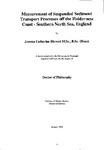Measurement of Suspended Sediment Transport Processes off the Holderness Coast - Southern North Sea, England
| dc.contributor.author | Blewett, Joanna Catherine | |
| dc.contributor.other | School of Biological and Marine Sciences | en_US |
| dc.date.accessioned | 2013-09-19T13:14:36Z | |
| dc.date.available | 2013-09-19T13:14:36Z | |
| dc.date.issued | 1998 | |
| dc.identifier | NOT AVAILABLE | en_US |
| dc.identifier.uri | http://hdl.handle.net/10026.1/1893 | |
| dc.description.abstract |
A field campaign was set up as part of the LOIS-RACS coastal program (1994-1996), to identify the near-bed physical processes responsible for suspended sediment movement in shallow water (10-20m depth) off the Holdemess coast, NE England. A new benthic tripod system Boundary Layer Intelligent Sensor System (BLISS) has been developed and deployed along a transect at three sites, normal to the coastline at Tunstall. Measurements of current velocity, suspended sediment concentration (SSC), pressure and CTD were recorded at 5 Hz for 17 minutes every hour, on the same data acquisition system. Results are presented for the summer, July 1995 and winter, February, 1996 deployments over two weeks. Results show that variation in the SSC signal is due to the advection of spatial gradients of SSC by the tidal flows and to the resuspension of sediment from the seabed. Alongshore advection is identified through a strong negative correlation between SSC and salinity, associated with the movement of low salinity, high turbidity water associated with the Humber plume to the south. Resuspension occurs predominantly during storms, when the influence of waves increases the friction velocity at the seabed (determined from measured turbulence spectra) above a threshold value. The threshold friction velocity in February 1996 was found to be approximately 0.023ms'', consistent with a partially consolidated fine sediment seabed. In July 1995, a much lower threshold velocity of 0.008 ms ' was measured and suggests that an unconsolidated layer of fine sediment can be deposited between the mild summer storms. After a winter storm, the decay time of the elevated SSC is consistent with a sediment settling velocity in the range (1.8-2.8) x 10"* ms"', a value which is associated with fine silt or flocculated clay particles. Sediment transport during the summer storms in July 1995 was onshore and is due to skewed shoaling waves suspending sediment during the shore-ward phase of the wave, as the wave crest passes. Offshore sediment transport dominated the February 1996 storms, and was due to a steady nearbed offshore flow explained by Stokes theory whereby a net flow in the direction of the wave advance near the surface will be balanced by a net flow in the opposite direction at depth. Sediment flux transport from waves along accounted for -10% of the total flux transported offshore. The storms are in fact, effective stirring mechanisms which increase the amount of sediment available for transport rather than actual transporters of suspended sediment. | en_US |
| dc.language.iso | en | en_US |
| dc.publisher | University of Plymouth | en_US |
| dc.title | Measurement of Suspended Sediment Transport Processes off the Holderness Coast - Southern North Sea, England | en_US |
| dc.type | Thesis | |
| plymouth.version | Full version | en_US |
| dc.identifier.doi | http://dx.doi.org/10.24382/4201 | |
| dc.identifier.doi | http://dx.doi.org/10.24382/4201 |
Files in this item
This item appears in the following Collection(s)
-
01 Research Theses Main Collection
Research Theses Main


